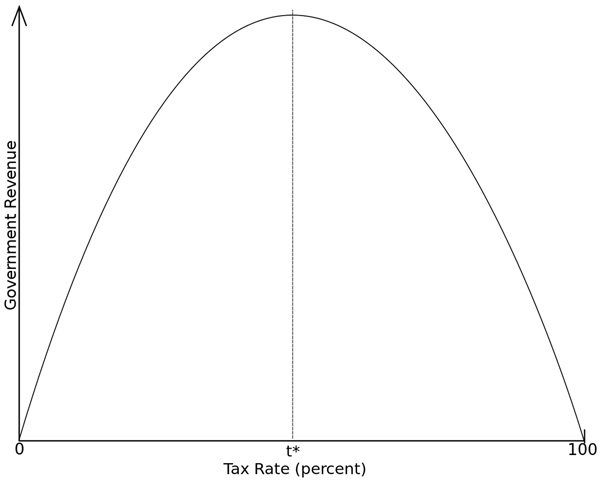Economist: We're Taxing the Wrong Things
Arthur Laffer is sticking to his guns about the hazards of over-taxing the economy.

Arthur Laffer is best known as the economist who invented the Laffer Curve, a diagram that purports to show how an optimal tax rate can maximize revenues without discouraging people from working. In an unexpected role, he recently co-authored a picture book for children called Let’s Chat About Economics! I interviewed Laffer and his co-author, Michelle Balconi, about the book for my Money-Smart Kids column.

Arthur Laffer
BODNAR: With regard to the children’s book, you said that the most important lesson you would like to teach kids is that trade-offs are the essence of economics: You can’t always have all the a you want and all the b you want. What’s the most important lesson you’d like adults to learn about economics?
From just $107.88 $24.99 for Kiplinger Personal Finance
Become a smarter, better informed investor. Subscribe from just $107.88 $24.99, plus get up to 4 Special Issues

Sign up for Kiplinger’s Free Newsletters
Profit and prosper with the best of expert advice on investing, taxes, retirement, personal finance and more - straight to your e-mail.
Profit and prosper with the best of expert advice - straight to your e-mail.
LAFFER: One lesson I’ve spent my life on is that when you tax something, you get less of it, and when you subsidize something, you get more of it. You know, we tax speeders to get them to stop speeding, and we tax cigarette smokers because we want them to stop smoking. And then we come along and tax people who work, and especially people who work very productively and make a lot of money. Do we do that to stop them from working and stop them from being productive? If you tax work, output and employment, and you subsidize non-work, leisure and unemployment, don’t be surprised if you get less work and a lot more leisure and unemployment. You can’t tax an economy into wealth.
What would you like policymakers to learn about economics? Same thing, or something different? Basically, policymakers should know where the limits of policy are, where government activities cease being better than private, and, vice versa, where private activities cease being better than government. Then you draw the lines and get the hell out of the way. You don’t want a private military, that’s for sure, and you don’t want public grocery stores. The law of diminishing returns is a perfect concept in this context.
So you think the Laffer Curve is still operational? It’s a basic principle of economics that’s always there. Sometimes we’re in a reasonable range of the Laffer Curve, and sometimes we’re not. In terms of what presidents Bush and Obama have done, we’ve gone outside the range and we’ve done a lot of damage to the economy because of government intervention. I think what presidents Reagan and Clinton did were exactly the right policies to create prosperity.
What do you think of the Fed’s zero-interest-rate policy? Forgive me, but I think it’s totally wrong. I mean, who wants to lend mortgage money at 3% to 3.5% for 30 years? The problem is that government people don’t understand that there’s both a supply curve and a demand curve. You can have interest rates that are too high and discourage borrowers, and interest rates that are too low and discourage lenders. There’s an interest rate right in the middle—the Goldilocks interest rate, if you will—where you get just the right amount of borrowers and lenders.
And we’re not there? The government is trying to set rates, which is the wrong thing to do, as opposed to letting the market set rates. That’s why we’ve had such a weak economic recovery. And they just keep on doing the same old policies. It’s really very sad, especially when you see kids in the inner city, teenagers who can’t get a job. After being unemployed for a while they become unemployable, and you’ve created a whole lost generation. We’re bearing the cost.
What made you decide to collaborate on a children’s book? For one thing, Michelle is the most energetic, enthusiastic, focused person you’ve ever seen. How could I say no? Also, I’ve been a professor all my life and a math person. What I try to do is take the math and bring it to life with things like the Laffer Curve or an example I use with Farmer A and Farmer B. In a world with only two people, Farmer A and Farmer B, if Farmer B gets unemployment benefits, who pays for them? Government doesn’t create resources, it redistributes resources. These aren’t the same examples you’d use with kids at the dinner table, but the idea is the same: Trade-offs are the key to economics.

Profit and prosper with the best of Kiplinger's advice on investing, taxes, retirement, personal finance and much more. Delivered daily. Enter your email in the box and click Sign Me Up.

Janet Bodnar is editor-at-large of Kiplinger's Personal Finance, a position she assumed after retiring as editor of the magazine after eight years at the helm. She is a nationally recognized expert on the subjects of women and money, children's and family finances, and financial literacy. She is the author of two books, Money Smart Women and Raising Money Smart Kids. As editor-at-large, she writes two popular columns for Kiplinger, "Money Smart Women" and "Living in Retirement." Bodnar is a graduate of St. Bonaventure University and is a member of its Board of Trustees. She received her master's degree from Columbia University, where she was also a Knight-Bagehot Fellow in Business and Economics Journalism.
-
 Should You Renew Your CD?
Should You Renew Your CD?With rate cuts impacting earnings, we examine if now is a wise time to renew CDs.
-
 7 Ways to Plan Now to Save on Medicare IRMAA Surcharges Later
7 Ways to Plan Now to Save on Medicare IRMAA Surcharges LaterUnderstand the critical two-year lookback period and why aggressive planning before you enroll in Medicare is the most effective way to minimize IRMAA.
-
 Law Reversal Looming? Trump Eyes 2026 Gambling Winnings Tax Change
Law Reversal Looming? Trump Eyes 2026 Gambling Winnings Tax ChangeTax Deductions It's no secret that the IRS is coming after your gambling winnings in 2026. But how long will that last?
-
 What to Expect from the Global Economy in 2026
What to Expect from the Global Economy in 2026The Kiplinger Letter Economic growth across the globe will be highly uneven, with some major economies accelerating while others hit the brakes.
-
 Amid Mounting Uncertainty: Five Forecasts About AI
Amid Mounting Uncertainty: Five Forecasts About AIThe Kiplinger Letter With the risk of overspending on AI data centers hotly debated, here are some forecasts about AI that we can make with some confidence.
-
 Worried About an AI Bubble? Here’s What You Need to Know
Worried About an AI Bubble? Here’s What You Need to KnowThe Kiplinger Letter Though AI is a transformative technology, it’s worth paying attention to the rising economic and financial risks. Here’s some guidance to navigate AI’s future.
-
 Will AI Videos Disrupt Social Media?
Will AI Videos Disrupt Social Media?The Kiplinger Letter With the introduction of OpenAI’s new AI social media app, Sora, the internet is about to be flooded with startling AI-generated videos.
-
 What Services Are Open During the Government Shutdown?
What Services Are Open During the Government Shutdown?The Kiplinger Letter As the shutdown drags on, many basic federal services will increasingly be affected.
-
 The Economy on a Knife's Edge
The Economy on a Knife's EdgeThe Letter GDP is growing, but employers have all but stopped hiring as they watch how the trade war plays out.
-
 Apple Readies for AI Upgrade with New iPhones
Apple Readies for AI Upgrade with New iPhonesThe Kiplinger Letter The tech giant has stumbled when it comes to artificial intelligence, but a new batch of iPhones will help it make headway.
-
 Japan Enters a New Era of Risk and Reform
Japan Enters a New Era of Risk and ReformThe Kiplinger Letter Japan has entered a pivotal moment in its economic history, undertaking ambitious policy and structural reforms to escape from decades of stagnation.